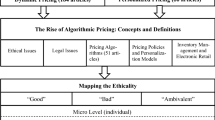Abstract
We suggest approximately optimal bidding strategies for games, where similar items are auctioned repeatedly. Considering players’ bounded rationality in practice, the results can further motivate the application of market-based approaches in resource allocation problems. We specialize the bidding algorithm for first-price payment schemes, the building blocks of several simplified selling mechanisms, that are common in practice.
Similar content being viewed by others
References
Ashlagi, I., Monderer, D., & Tennenholtz, M. (2006). Robust learning equilibrium. In Proc. 22th annual conf. on uncertainty in artificial intelligence (UAI’06) (pp. 34–41).
Aumann, R. J. (1997). Rationality and bounded rationality. Games and Economic Behavior, 21(1–2), 2–14.
AuYoung, A., Buonadonna, P., Chun, B. N., Ng, C., Parkes, David C., Shneidman, J., Snoeren, A. C., & Vahdat, A. (2009). Two auction-based resource allocation environments: design and experience. In R. Buyya & K. Bubendorfer (Eds.), Market oriented grid and utility computing. New York: Wiley.
Danak, A., & Mannor, S. (2011a). Efficient bidding in dynamic grid markets. IEEE Transactions on Parallel and Distributed Systems, 22(9), 1483–1496.
Danak, A., & Mannor, S. (2011b). A robust learning approach to repeated auctions with monitoring and entry fees. IEEE Transactions on Computational Intelligence and AI in Games, 3(4), 302–315.
Fatima, S. (2006). Sequential versus simultaneous auctions: a case study. In Proc. 8th int. conf. on electronic commerce (ICEC’06) (pp. 82–91).
Ferguson, N. B., & Finlayson, B. A. (1972). Error bounds for approximate solutions to nonlinear ordinary differential equations. The American Institute of Chemical Engineers (AIChE) Journal, 18(5), 1053–1059.
Guerre, E., Perrigne, I., & Vuong, Q. (2000). Optimal nonparametric estimation of first-price auctions. Econometrica, 68(3), 525–574.
Hart, S., & Mansour, Y. (2010). How long to equilibrium? the communication complexity of uncoupled equilibrium procedures. Games and Economic Behavior, 69(1), 107–126.
Hausch, B. D. (1986). Multi-object auctions: sequential vs. simultaneous sales. Management Science, 32(12), 1599–1610.
Hon-Snir, S., Monderer, D., & Sela, A. (1998). A learning approach to auctions. Journal of Economic Theory, 82(1), 65–88.
Hörner, J., & Jamison, J. (2008). Sequential common-value auctions with asymmetrically informed bidders. Review of Economic Studies, 75(2), 475–498.
Jofre-Bonet, M., & Pesendorfer, M. (2003). Estimation of a dynamic auction game. Econometrica, 71(5), 1443–1489.
Kagel, J. H., & Levin, D. (2002). Common value auctions and the winner’s curse. Princeton: Princeton University Press.
Milgrom, P. R., & Weber, R. J. (1982). A theory of auctions and competitive bidding. Econometrica, 50(5), 1089–1122.
Pepper, D. W., & Heinrich, J. C. (2006). The finite element method: basic concepts and applications. London: Taylor & Francis.
Roth, A. E., & Erev, I. (1995). Learning in extensive-form games: Experimental data and simple dynamic models in the intermediate term. Games and Economic Behavior, 8(1), 164–212.
Zienkiewicz, O. C., Taylor, R. L., & Zhu, J. (2005). The finite element method: its basis and fundamentals (6th ed.). Stoneham: Butterworth.
Author information
Authors and Affiliations
Corresponding author
Rights and permissions
About this article
Cite this article
Danak, A., Mannor, S. Approximately optimal bidding policies for repeated first-price auctions. Ann Oper Res 196, 189–199 (2012). https://doi.org/10.1007/s10479-012-1148-8
Published:
Issue Date:
DOI: https://doi.org/10.1007/s10479-012-1148-8




